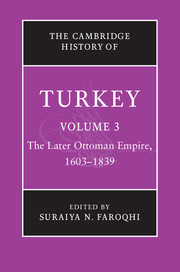Book contents
- Frontmatter
- PART I BACKGROUND
- PART II AN EMPIRE IN TRANSITION
- PART III THE CENTRE AND THE PROVINCES
- PART IV SOCIAL, RELIGIOUS AND POLITICAL GROUPS
- PART V MAKING A LIVING
- 14 Capitulations and Western trade
- 15 Guildsmen and handicraft producers
- 16 Declines and revivals in textile production
- 17 Rural life
- PART VI CULTURE AND THE ARTS
- Glossary
- Bibliography
- Index
- References
17 - Rural life
from PART V - MAKING A LIVING
Published online by Cambridge University Press: 28 March 2008
- Frontmatter
- PART I BACKGROUND
- PART II AN EMPIRE IN TRANSITION
- PART III THE CENTRE AND THE PROVINCES
- PART IV SOCIAL, RELIGIOUS AND POLITICAL GROUPS
- PART V MAKING A LIVING
- 14 Capitulations and Western trade
- 15 Guildsmen and handicraft producers
- 16 Declines and revivals in textile production
- 17 Rural life
- PART VI CULTURE AND THE ARTS
- Glossary
- Bibliography
- Index
- References
Summary
Births, marriages, deaths and migrations
While the vast majority of Ottoman subjects lived in the countryside, mostly as peasants or else as nomads, it is impossible to be precise about numbers. Few tax registers of the type for which the sixteenth-century Ottoman administration had become famous were compiled after 1600, and those that were have often survived only in fragments. To fill the gap researchers have attempted to estimate rural population on the basis of the ‘tax houses’ made up of several families that in the seventeenth century, in place of ‘real’ households, formed the basis for assessing the payments and services known as avarız. But ‘tax houses’ comprised a highly variable number of real households, and it is only if the sources give us equivalencies that these registers become usable for population estimates; however, this information is by no means available in all cases.
Moreover, in the eighteenth century so many taxes came to be collected by lifetime tax-farmers that counts of the taxable population became irrelevant. Therefore, throughout the period treated we can only estimate population for certain limited regions. Only shortly after our period had ended, in the 1840s, was a further set of counts initiated, which appears promising for demographic studies, but as yet the critical evaluation of this material is only in its beginning stages.
In Anatolia and some parts of Greece, as well as in Palestine, certain areas lost population in quite a dramatic fashion during the political troubles and climatic irregularities of the early seventeenth century, with a low point around 1640–50.
- Type
- Chapter
- Information
- The Cambridge History of Turkey , pp. 376 - 390Publisher: Cambridge University PressPrint publication year: 2006
References
- 1
- Cited by



